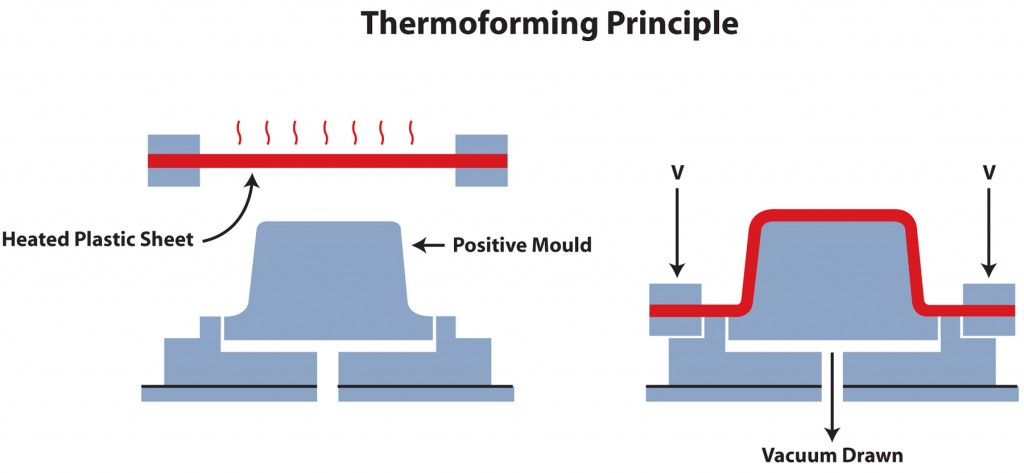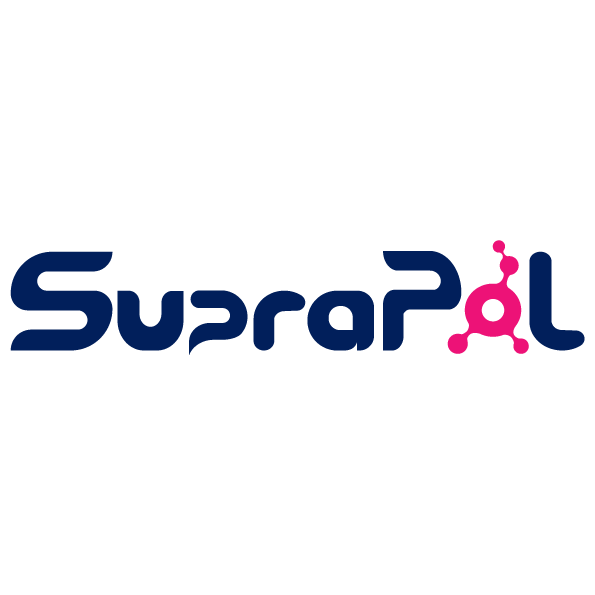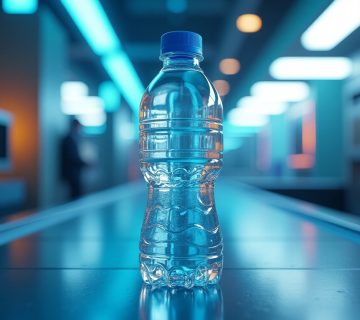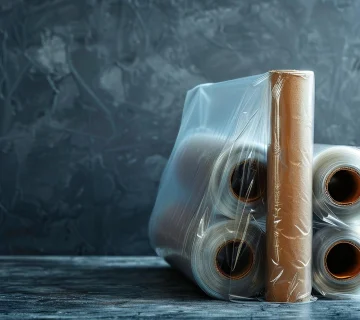Thermoforming is a prevalent plastic manufacturing technique that involves heating a thermoplastic sheet to a malleable temperature, shaping it into a designated form, and subsequently trimming it to produce a functional product. This adaptable process is vital in multiple sectors, including packaging, automotive, medical devices, and consumer goods. The capability of thermoforming to yield detailed, robust, and lightweight products renders it an essential method in contemporary manufacturing.
What is Thermoforming?
Thermoforming is a manufacturing technique in which a plastic sheet is heated until it becomes soft and pliable. The softened sheet is then placed over a mold and shaped into the desired form by applying pressure or vacuum. Once the plastic cools and solidifies, it is trimmed to eliminate surplus material, resulting in the final product.
Thermoforming is generally categorized into two primary types:
• Vacuum Forming: In vacuum forming, a heated plastic sheet is stretched over a mold, and a vacuum is applied to remove the air, causing the sheet to conform to the mold’s shape.
• Pressure Forming: Pressure forming is akin to vacuum forming, but it incorporates additional pressure applied to the top of the plastic sheet, allowing for more intricate and detailed shapes.
The Thermoforming Process
The thermoforming process typically consists of several essential steps:
Material Selection
The process starts with the selection of suitable thermoplastic material. Common materials utilized in thermoforming include ABS, PVC, polystyrene, polyethylene, and polycarbonate, each providing various characteristics such as flexibility, strength, and chemical resistance.
Heating
The plastic sheet is heated to a specific temperature, usually between 250°F and 350°F (120°C to 180°C), depending on the material. This heating is conducted using ovens, infrared heaters, or other heating systems to ensure uniform pliability throughout the sheet.
Forming
Once heated, the pliable plastic sheet is placed over a mold. In vacuum forming, a vacuum draws the plastic tightly against the mold, while in pressure forming, additional air pressure is employed to push the plastic into the mold’s intricate details.
Cooling
After the sheet has taken the shape of the mold, it is allowed to cool and solidify. Cooling can be expedited using fans, cool air, or water mist to minimize cycle times and enhance production efficiency.
Trimming
The formed plastic part is then trimmed to eliminate any excess material. Trimming can be accomplished through various methods, including CNC machining, laser cutting, or manual trimming, depending on the required precision.
Finishing and Assembly
Finally, the trimmed parts may undergo additional finishing processes, such as painting, coating, or assembly with other components to create the final product.

Applications of Thermoforming
Thermoforming is employed across a wide array of industries due to its versatility and cost-effectiveness. Some of the most prevalent applications include:
Packaging
One of the largest markets for thermoformed products is the packaging industry. Thermoforming is utilized to create clamshell packaging, blister packs, trays, and containers for food, electronics, medical devices, and consumer goods. This method enables the production of lightweight, protective, and visually appealing packaging, making it an ideal choice for various products.
Automotive
In the automotive sector, thermoforming is utilized to manufacture interior components such as dashboards, door panels, and trunk liners. This process facilitates the creation of durable, lightweight parts available in various textures and colors to meet design requirements.
Medical Devices
In the medical field, thermoforming is frequently employed to produce custom trays, sterile instrument packaging, and housings for medical equipment. Its capacity to create precise, hygienic, and safe components makes it essential in this industry.
Consumer Goods
Numerous household items, including appliance housings, sports equipment, and storage containers, are produced using thermoforming. This process allows for the manufacturing of items with complex shapes and durable finishes, making it suitable for high-use consumer products.
Signage and Displays
Thermoforming is also utilized to create large, eye-catching signs and displays, particularly in retail environments. This process enables the production of 3D shapes and intricate designs that stand out in commercial settings.
Advantages of Thermoforming
Thermoforming presents several advantages that contribute to its popularity as a manufacturing process:
Cost-Effectiveness
Thermoforming is often more cost-effective than other molding processes, especially for smaller production runs. The molds required for thermoforming are less expensive to produce and maintain in comparison to those used in injection molding or blow molding.
Versatility
Thermoforming accommodates a wide range of products, from small intricate parts to large components. It can work with various materials to produce products with differing thicknesses, textures, and finishes.
Rapid Prototyping
The relatively low cost and speed of mold production in thermoforming make it ideal for prototyping and testing new designs before large-scale production commitment.
High Detail and Precision
Particularly, pressure forming allows for high detail and precision, presenting a viable alternative to more expensive processes like injection molding.
Lightweight Products
Thermoformed products are typically lightweight, which is advantageous in industries where weight reduction is critical, such as automotive and aerospace.

Challenges of Thermoforming
Despite its many benefits, thermoforming does have some limitations:
Material Waste
The trimming process in thermoforming can produce material waste, especially when crafting complex shapes. However, this waste can often be recycled and reused in subsequent production runs.
Limited to Thin-Walled Products
Thermoforming is primarily limited to producing thin-walled parts, making it less suitable for products requiring thicker, more robust walls.
Mold Costs for High Volumes
Although mold costs for thermoforming are lower compared to other processes, they can still become significant for very large production volumes, thereby making other molding methods more cost-effective in such instances.
Environmental Impact
Thermoforming relies substantially on plastics, raising concerns regarding environmental sustainability. Nevertheless, advancements in recycling and the adoption of bio-based materials are helping to address these issues.
The Future of Thermoforming
The future of thermoforming appears promising, driven by the increasing demand for lightweight, cost-effective, and durable products. Innovations in material science, particularly the development of more sustainable and recyclable plastics, are expected to enhance the environmental credentials of the process. Furthermore, advancements in automation and digital technology are anticipated to improve the efficiency and precision of thermoforming, making it more competitive in the global market.
The integration of smart manufacturing practices, including the use of IoT (Internet of Things) and AI (Artificial Intelligence), is also expected to play a vital role in the evolution of thermoforming. These technologies can optimize production processes, reduce waste, and enhance product quality, ensuring that thermoforming remains an essential manufacturing method in the future.
Thermoforming is a versatile and cost-effective manufacturing process that is crucial in producing a wide array of products across various industries. Its capability to create detailed, durable, and lightweight parts renders it an indispensable technique in modern manufacturing.
While challenges exist within thermoforming, ongoing innovations in materials and technology are set to address these issues and uphold the process’s relevance. As industries advance and the demand for efficient, sustainable manufacturing increases, thermoforming will continue to be a key process in shaping the future of product design and production.




No comment